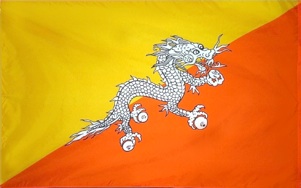Balkans 2016
Balkans 2016 Albania Kosovo Macedonia

Bhutan
2018
There are very few more isolated travel destinations than Bhutan. North Korea and Saudi Arabia control their tourism arrivals a little more tightly, but Bhutan is up there in the same league. This tiny landlocked kingdom in the Eastern Himalayas appears as a tiny dot on the map, squeezed between the Tibetan Plateau of China to the north and regions of Assam and West Bengal in India to the south.
Because of its isolation and the fact that it was never colonised, Bhutan retains an intact centuries old culture based on Buddhism (which was introduced in the 7th century). Known as “Land of the Thunder Dragon”, Bhutan is pioneering the concept of Gross National Happiness (GNH) to measure its economic development. Although some commentators dismiss this as shameless self-promotion of its economic poverty, perhaps GNH makes sense in a country that ranks first in South Asia for peace, ease of doing business and absence of corruption. To support its priority to raise GNH, Bhutan was the first country in the world to prohibit smoking, and it banned television for decades before ultimately relenting and allowing Indian satellite broadcasts – which led to a measurable fall in GNH! Bhutan is the only country in the world that is a net carbon sink – it absorbs more carbon than it produces. The country’s focus on GNH also explains the tight control placed on the annual intake of tourists.
When my Druk Air Airbus A319 touched down at Paro Airport this morning at 10:24am after its short flight from Kolkata (formerly Calcutta, India), I couldn’t help wondering whether my visit would raise or lower Bhutan’s GNH. Of course, I hoped my impact might be to increase GNH – a worthy aspiration indeed for every visitor to Bhutan. Of course, if people’s happiness is raised by increasing wealth (a highly debated topic in Bhutan), then my visit should help, because in addition to its natural isolation, Bhutan controls its tourist intake by charging and collecting some fairly savage fees.
In order to get a Bhutanese tourist visa, visitors must pre-pay US$250 per day for their visit. This isn’t quite as harsh as it sounds at first, however, because it includes all accommodation (in 3-star guesthouses), three meals per day, all transport costs, entry fees and the compulsory guide fees. The daily fee is still far from cheap, but it helped knowing that my payment was partly a price on conservation and environmental sustainability.
When I stepped from the plane on arrival in Paro, a tiny airstrip in an alpine valley in western Bhutan, I was immediately struck by the clean if misty air, the sense of quiet calmness, and the spectacular mountains surrounding me – all in stark contrast with the heat, humidity, fumes, smells, noise, squalor and frenetic activity in Kolkata (India) where I had spent the previous day en route. My initial impression of Bhutan was of a very special place where arrival was just the beginning of a real privilege – that of visiting this mountain kingdom.
Upon exiting the airport, we were met by Dhendup (our guide) and Tinlay (our driver). Although it was officially the ‘dry’ season, there was light rain falling, so Dhendup advised us to go to our hotel, rest a while, and then go out to lunch. Our hotel, the Drukchen Hotel, was located on a hill (of course; this IS the Himalayas!) overlooking Paro Airstrip, and was spacious and comfortable if somewhat basic.
After a light buffet lunch in Paro township, we set out for the short drive to our one and only destination for the day, the Paro Dzong. In Bhutan, ‘dzong’ means fortress or castle, and this one was a beauty, having been built in in 1644 with cliff-like buttressed walls in a style that was reminiscent of Tibetan architecture.
The main building, known as Rinpung Dzong, still functioned as a working building, one half being a Buddhist monastery and the other half district government offices and law courts. We took our time exploring this huge building, with its towering white walls, rich yellow material decorations, bright frescoes and beautiful timbered windows.
We then proceeded to an open courtyard paved with stone up the hill from the Rinpung Dzong where the annual Paro tshechu was into its third day. Tshechus are festivals that focus on dance dramas performed by monks in colourful costumes and painted masks that portray traditional stories. The Paro tshechu is one of Bhutan’s largest, and as we approached the ground where it was being formed, we joined hundreds of local people who were sitting and standing around the performance, spreading upwards across the steep slopes of a nearby hill.
The performers played the roles of heroes, demons, animals, princes and princesses, deities and clowns, and it was evident by the audience’s reaction that the performance was deeply appreciated. We were given a small booklet that helped us keep track of the storyline, but even without this, the colour, movement, music and atmosphere made the experience intoxicating.
All too soon, today’s performances ended with the conversion to Buddhism of a hunter named Gonpo Dorji by the great Buddhist saint Jetsun Milarepa, together with the subsequent (but apparently less significant) conversions of a deer and two dogs. By the time we dispersed, the grey clouds had built up in the sky overhead and the temperature had begun its diurnal plummet. Fortunately, the Drukchen Hotel has good heaters and electric blankets.

Day 1 - Arrival in Bhutan
Thursday 29 March 2018














